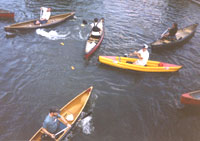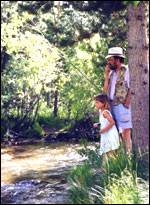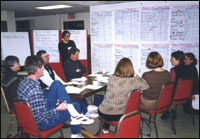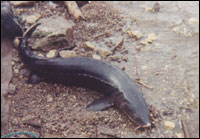Lisa Goodman is the northern coordinator for local group assistance at the River Alliance of Wisconsin, a statewide nonprofit that advocates for the protection, enhancement, and restoration of Wisconsin’s rivers and watersheds.

Tuesday, 27 May 2003
MADISON, Wis.
Today began with a paddle. It is a short portage from house to river. Crossing a street and carrying the boat a block, I am on the water in five minutes. Moving upriver in the cool morning sunshine — what better way to start the day? Later, at the office, the day will kick into high gear. This is my time.
My local river is the Yahara River, which makes its way through a mix of farmland, wetlands, and urban areas, linking the local lakes, before finding its way to the Rock River and the Mississippi. As I paddle, I think about the river.
At work I think about many rivers. I work for the River Alliance of Wisconsin, Wisconsin’s statewide river conservation organization.
It’s not easy to keep the two worlds separate. Thinking about land use, and how it affects water, even the smallest things have an impact. The runoff from lawns and pavement, the grass clippings and debris in the gutters along my street will end up in this river if it rains tonight. The additional nutrient load changes the river’s chemistry, setting off a cascade of events. Fortunately, this is preventable. Many municipalities have street sweeping programs. Individuals and businesses can keep homes, businesses, and construction sites from contributing excess debris, fertilizer, sediment, and pollutants to local waters.
Last spring some of the neighbors stenciled the storm sewer grates with, “Dump no waste, drains to river.” One neighbor came out to ask what we were doing. She does not read English. We talked about how we live and how we affect what lies downstream. The expression comes to mind, “We all live downstream.” How can we get the message across?
An hour passes swiftly on the water. I carry the boat home, thinking about the day ahead. Simple morning thoughts and tempo are about to give way to another day at the office. We are six full-time staff at the River Alliance — or we will be again, soon. Today we will conduct final interviews for a new executive director. In addition to an E.D., we are an office manager, a member services manager, dams program manager, and two local group assistance program staff members. With the local groups program manager covering southern Wisconsin, I serve as a resource person for community-based river and watershed organizations in the northern half of the state. Our program provides technical assistance with fundraising, organizational development, campaigns, and more via workshops and training opportunities, educational materials, one-on-one consultation, network contacts, a listserv, and a variety of other tools.
Wisconsin has designated 2003 the Year of Water. Ironic. Our legislature is currently working to approve the state budget. In the face of a staggering deficit, everything is fair game on the legislative chopping block, including funding for our waters. We sent out action alerts to elicit citizen support. Thanks to a strong outpouring of support from the network of local groups, funding for river and lake grants and water staff at the Department of Natural Resources appears to be safe, for now.
Wednesday, 28 May 2003
MADISON, Wis.
I began the day with a bit of puttering in the garden. Though the weather forecast had predicted overnight rain, there was only a trace more water in the rain barrel. The sunflower crop looks promising, if a bit on the dry side, so I hit the young plants with a quick watering before leaving for work. Yesterday’s final executive director interviews went well. The candidates we interviewed were very well-qualified, and the final decision will be difficult. Local Group Assistance Program Manager Diana Toledo has been very capably holding down two jobs here, piloting the River Alliance of Wisconsin while continuing to run the Local Groups program. Without an executive director, we have all had the opportunity to pitch in on grant writing, media efforts, and related work. It has been a good opportunity to grow closer and to add to our skills, but we’re looking forward to having a new director on board soon.
During the interviews, the executive director candidates have been asking staff about the River Alliance’s work and the role each of us plays. The five of us have very different jobs, but there are a variety of projects to which we all contribute ideas and energy. We enjoy brainstorming together, and I’m always impressed by the diversity of perspectives we bring to these confabs and the ideas we cook up. Mike brings his valuable dual background in law and music. Helen lends her top-notch ecologist training and refreshing Canadian perspective, Diana, her great wisdom and knowledge about regional and national resources, and Otis his computer wizardry and marketing savvy. For my part, I contribute networking contacts, paddling know-how (which comes in especially handy when we’re doing on-water events), and incurable optimism. Among us, we have a wealth of ideas and connections.

Dueling laptops: Mike and Otis take notes during the strategic planning retreat.
Photo: Lisa Goodman.
July 2003 will mark our organization’s 10th anniversary. In those 10 years, we have grown to seven full-time staff, plus several part-time interns. We enjoy the support of more than 1,700 individual and business members and nearly 50 organizational members. With our board of directors, we have been working to establish a slate of 10th anniversary events and projects. The most significant of these will be our 10th Anniversary Dinner, on November 15. We are working to identify and book a prominent keynote speaker for that event. The annual dinner program will also include the presentation of River Champion awards and a silent auction. Months of preparation go into lining up auction donations, seeking award nominees, and handling the many details that go with staging such an event. We all pitch in to make it come together.
We are also collectively involved in writing the River Alliance strategic plan for the next three years, as our current plan will expire in 2003. In April, we held a retreat with our board to begin to address 2004 to 2006. It’s exciting to be involved in charting the course for the organization and our program for the coming years. During the next few months, we will work to finalize the plan, and we will be ready to begin implementing it in 2004.
Today, I’m preparing for a meeting with one of our major funders and continuing to work with northern river groups to schedule organizational assessments. Our board chair just walked in for an impromptu meeting, so more on this tomorrow.
Thursday, 29 May 2003
MADISON, Wis.
Today I have a meeting with one of our major funders. The coffee pot is on and I have taken a moment to tidy up the office. The River Alliance is fortunate to enjoy the support of several foundations, and we look forward to opportunities to visit with foundation representatives, bring them up to date on our work, and hear what they are thinking.
Dams Program Manager Helen Sarakinos is off to North Carolina for the next few days. She has been invited to teach a dam-removal workshop to river advocates in the Southeast. The River Alliance helped write the book about small dam removal — literally. To date, more than 2,000 copies of Dam Removal: A Citizen’s Guide to Restoring Rivers have been shipped to eight countries. Last year, the video, Taking a Second Look: Communities and Dam Removal, won a “Best Documentary” award from the Outdoor Writers Association of America.
After the meeting, other noteworthy projects I’ll be working on today include scheduling summer workshops with northern organizations and working on a pair of stories for the upcoming newsletter. Thanks to our contributions and Otis’s editorial skills, we produce a quarterly newsletter, Wisconsin Rivers.
Our 2003 workshops promise to be exciting. All of them involve getting out around the state to share tools with our member organizations, Wisconsin’s community-based river and watershed groups. One workshop will involve training citizens to use the Clean Water Act to protect their home waters. Our new publication, Using the Clean Water Act to Protect Wisconsin’s Waters will be the text for that workshop.
We will also be working with river organizations’ boards of directors to conduct organizational assessments. By taking stock of where they are, in terms of projects and goals, internal communications, membership, fundraising and more, groups can better prioritize and take home action plans to help guide their future work.

Musical guests White Water wow a sellout crowd at the recent FCLARA Wild Rivers Celebration.
Photo: Lisa Goodman.
One organization we look forward to seeing is the Florence County Lakes and Rivers Association. It has been engaged in a number of projects, including a lengthy campaign to safeguard the county’s protective shoreland zoning ordinance. Florence County is home to two of Wisconsin’s three state-designated Wild Rivers. The associaton’s hard work is not over, but two weeks ago, FCLARA members took a rare time-out to celebrate and reflect on all they have accomplished. Their Wild Rivers Celebration was a great success, with a standing-room-only crowd filling the Florence Natural Resource Center to attend a cookout, see a new mural dedicated, and listen to the talented band, White Water. It was wonderful to see this energetic group smiling and celebrating. The event served as a valuable reminder to all that there needs to be celebration to balance out the hard work.
After work yesterday, Helen and I canoed the Yahara River. At that time of day, there is a great deal of activity along the river. In addition to a green heron and many ducks, we encountered joggers, bicyclists, anglers, and power boaters, as well as the weekly gathering of dead fish polo enthusiasts.

Dead fish polo enthusiasts on the mighty Yahara River.
Photo: Lisa Goodman.
Dead fish polo combines elements of dodgeball and water polo with canoeing. The genesis of this sport is said to have occurred during a quiet outing when a mischievous paddler deftly used a paddle to deposit a recently-departed fish in a companion’s canoe. Fortunately, the sport has been refined to the point where paddlers now use sponges instead of fish. There can be almost as many sponges in play as there are paddlers, which makes for a wet and lively game. While working to nail a fellow player, a paddler must remember to keep an eye on her own stern.
We paddled until nearly dusk, chatting and experimenting with different strokes. Being on the water is both relaxing and invigorating. The energizing part is staying connected with what it’s all about and not taking oneself too seriously all the time. And not getting burned out. One of the members of our advisory committee recently shared with me Edward Abbey’s words:
Be as I am — a reluctant enthusiast … a part-time crusader, a half hearted fanatic. Save the other half of yourselves and your lives for pleasure and adventure. It is not enough to fight for the land; it is even more important to enjoy it. … Enjoy yourselves, keep your brain in your head and your head firmly attached to the body, the body active and alive.
Friday, 30 May 2003
MADISON, Wis.
We have had some rain this week, enough to add about 15 gallons more to the rain barrel. There is something very satisfying about peering beneath the barrel lid after a storm to take stock of the latest “harvest.” This barrel enables me to irrigate “off the grid” between rains, rather than drawing from the municipal water supply. And the untreated water is said to be better for plants. Using rain barrels is also a way to help slow and redirect urban stormwater runoff, countering the tendency for water to flow directly from downspouts to storm sewers.

Kathy and Chuck Steudel at their favorite secret fishing hole.
Photo: Chuck Steudel.
Wisconsin is blessed with more than 44,000 miles of rivers and about 15,000 lakes. Even living in a Great Lakes state, where water has historically been thought of as unlimited, we have come to realize that we can’t take water quality — or quantity — for granted. Luna Leopold said, “Water is the most critical resource issue of our lifetime and our children’s lifetime. The health of our waters is the principal measure of how we live on the land.” In fact, the United Nations has proclaimed 2003 the International Year of Freshwater.
In the 1990s, a major bottler, Perrier, sought to withdraw large volumes of water from central Wisconsin, to the dismay of many local communities. (Check out a Grist article on this.) The citizens were rightly concerns that unregulated withdrawal of large volumes of water can have adverse effects on groundwater and surface waters. Recognizing that these issues are likely to become more commonplace, the River Alliance has spent the last couple of years talking them over with agriculture interests, university scientists, and other partners. Thanks in part to this important dialogue between diverse interests, Wisconsin hopes to enact groundwater quantity legislation soon.
As I mentioned earlier, there’s no way to keep work separate from the rest of life when your job concerns rivers. I think about them at work, swim in them, fish them, paddle them, read about them, and dream about them. River reading is another activity that ranks high on my list of fun homework. One book currently on my nightstand is River Life: The Natural and Cultural History of a Northern River, by John Bates. Bates, a writer, naturalist, and guide based in Wisconsin, is, to me, the voice of northern rivers. His clear writing and captivating descriptions of natural phenomena command respect for our waters and their inhabitants.
Also in the “fun homework” category, I recently had the opportunity to take a fly-tying class. Shortly thereafter, I purchased my first flyrod. A couple of generous flyfisher friends have offered lessons, and I look forward to joining them on the water this season. During college, I discovered entomology. What began as a required course quickly became a fascination that will captivate me for the rest of my days. Fishing is, for me, an opportunity to combine an interest in aquatic entomology with a respect and appreciation for fish and a love of water.

The River Alliance’s Diana Toledo leads a workshop for the Token Creek Watershed Association.
Photo: Lisa Goodman.
At present, there are more than 100 community-based river and watershed organizations active in Wisconsin, and 600 to 700 lake associations. There are also many chapters of Trout Unlimited, countless sporting organizations, and a growing number of land trusts. To me, these groups embody the idea that “just plain folks” can make a difference. By getting involved in causes like river conservation, they are effecting change for future generations. As one of our board members says, “I do this work for my grandson’s fish.”
I serve northern Wisconsin. When I’m at my desk or on the road, one of the messages that comes across loud and clear is a sense of urgency. The challenge is to protect rivers from degradation and unplanned development. Without a doubt, we will continue to see greater development in northern Wisconsin. Lakefront property has been in high demand, and as it becomes more scarce, the focus is shifting to rivers. Our northern organizations are asking for help in protecting their home waters for future enjoyment. They understand that development will occur, but they seek thoughtful, planned growth. In this time of decreasing funding for state agencies, these citizen groups are also able to help pick up where agency staff must sometimes leave off. The groups accomplish everything from river cleanups and fish habitat restoration to establishing water trails, watchdogging local polluters, and campaigning for selective small-dam removal.
In the words of Margaret Mead, “Never doubt that a small group of thoughtful, committed citizens can change the world; indeed it’s the only thing that ever has.” On that note, I encourage you to join your local river or watershed group, and get involved in their work. If you don’t have a local group, start one. As we say at the River Alliance of Wisconsin, a healthy river is the heart of a healthy community.


